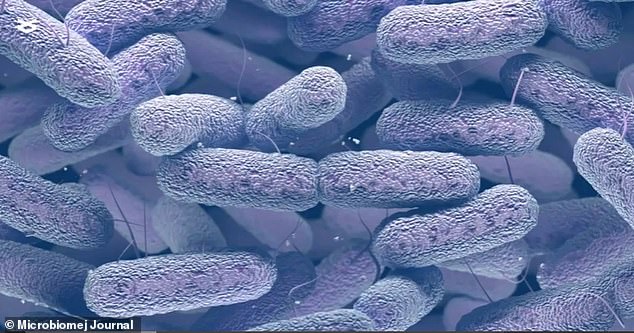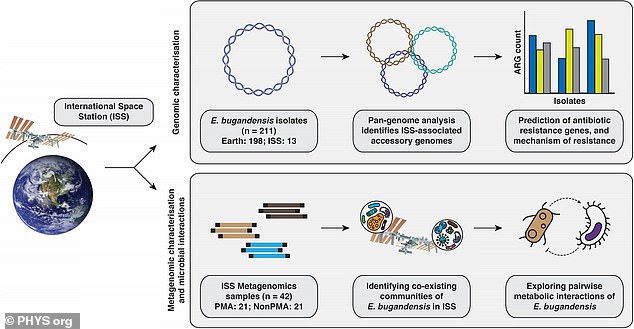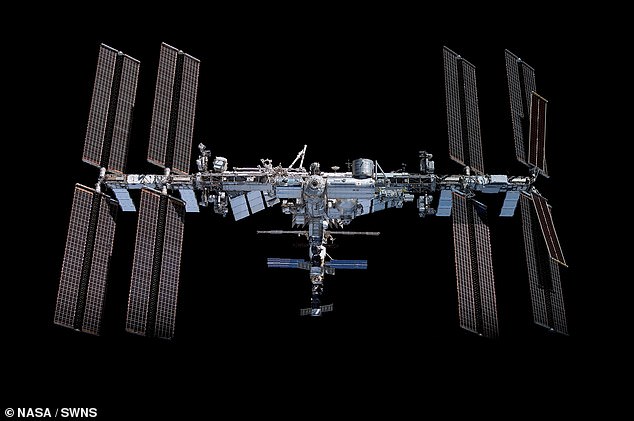It may seem like the plot of a new Alien movie, but NASA has found a mutant bacteria that thrives in space.
Researchers discovered 13 strains of the bacteria, called Enterobacter bugandensis, which is linked to blood infections on the International Space Station (ISS), which could compromise the health of astronauts on board.
The extreme environment on the ISS, such as higher levels of carbon dioxide, forced bacteria to mutate, and when exposed to microgravity, bacteria can acquire resistance to antibiotics.
The bacteria hitchhiked the astronauts to the orbital laboratory and now the researchers have warned that microgravity can affect their health, making them more susceptible to infection by the bacteria.
The International Space Station was built in 1998 and has hosted 300 astronauts over the past two decades. Scientists have discovered a mutant bacteria that could pose a harmful risk to astronauts.

A mutated form of the E. bugandensis bacteria (pictured) was found on the ISS and developed resistance to the drugs. The bacteria has been linked to sepsis in babies and to life-threatening infections that could cause inflammation of the inner lining of the heart’s chambers and valves.
The mutation placed the bacteria in the ESKAPE group of pathogens, bacteria that are the leading cause of infections contracted while receiving medical care.
The bacteria have been linked to serious infections, such as a blood infection found in babies called neonatal sepsis.
Enterobacter infections can also lead to sepsis, urinary tract infections, skin and soft tissue infections, and endocarditis, a life-threatening inflammation that occurs in the inner lining of the heart’s chambers and valves.
Researchers first discovered that there were microorganisms living among astronauts in 2019 while conducting an extensive study of fungi and bacteria living on the ISS, but they recently identified the main bacteria as E. bugandensis.
The team identified 13 strains of the bacteria in three locations on the ISS: four in the air circulation system, one in an exercise machine and eight in the laboratory bathroom.

The researchers put together an illustration showing the process they used to analyze E. bugandensis and assess how it adapts within the ISS habitat (pictured).
During their research, the scientists took three steps to identify the bacteria’s mutation rather than just comparing the E. bugandensis found on the ISS to the variation found on Earth.
First, the team analyzed how the bacteria’s genomes and functionality changed during adaptation to the extreme environment of space before moving on to the second step, where they identified the abundance of the E. bugandensis population on the ISS.
Finally, they looked at the metabolic interactions of bacteria that benefit other microorganisms, helping them survive and grow.
“The results of the study indicate that, under stress, strains isolated from the ISS mutated and became genetically and functionally distinct compared to their counterparts on Earth,” NASA reported.
“The strains were able to viably persist on the ISS over time in significant quantities,” he added.
“The ISS genomes had an average of 4,568 genes, a significantly higher count than the average of 4,416 genes found in Earth genomes,” the team explained in the study.
The researchers determined that the mutant strains also had completely different genes that could have caused their ability to resist multiple drugs.
Although a variation of E. bugandensis exists on Earth, the environment aboard the space station offered extreme conditions such as microgravity (very low or weak gravity), solar radiation, and high levels of carbon dioxide that forced the bacteria to mutate to survive.
Other factors such as ventilation, humidity and air pressure could have helped E. bugandensis thrive, according to the study, adding that the bacterial strain could coexist with other microorganisms on the ISS and could have contributed to its survival.
The scientists said that by studying how microorganisms survive in extreme environments on the ISS, “this research opens the doors to effective preventive measures for the health of astronauts.”

